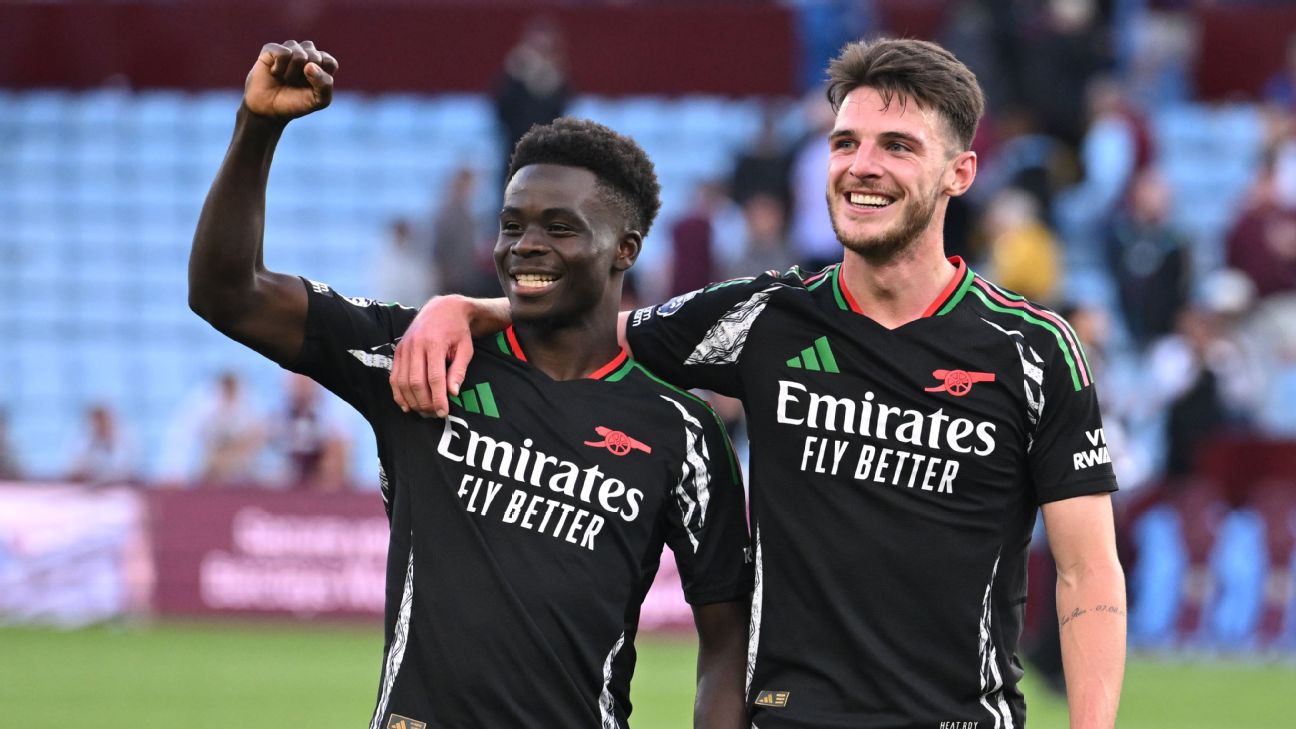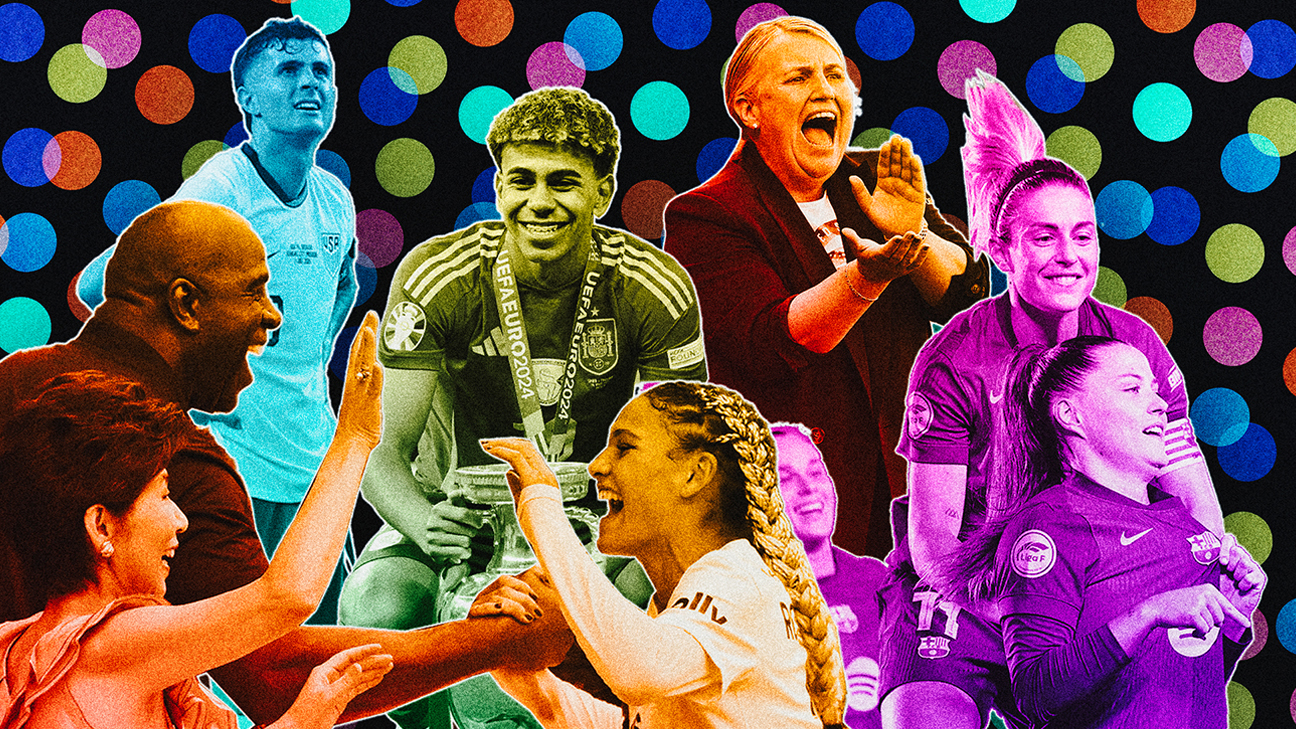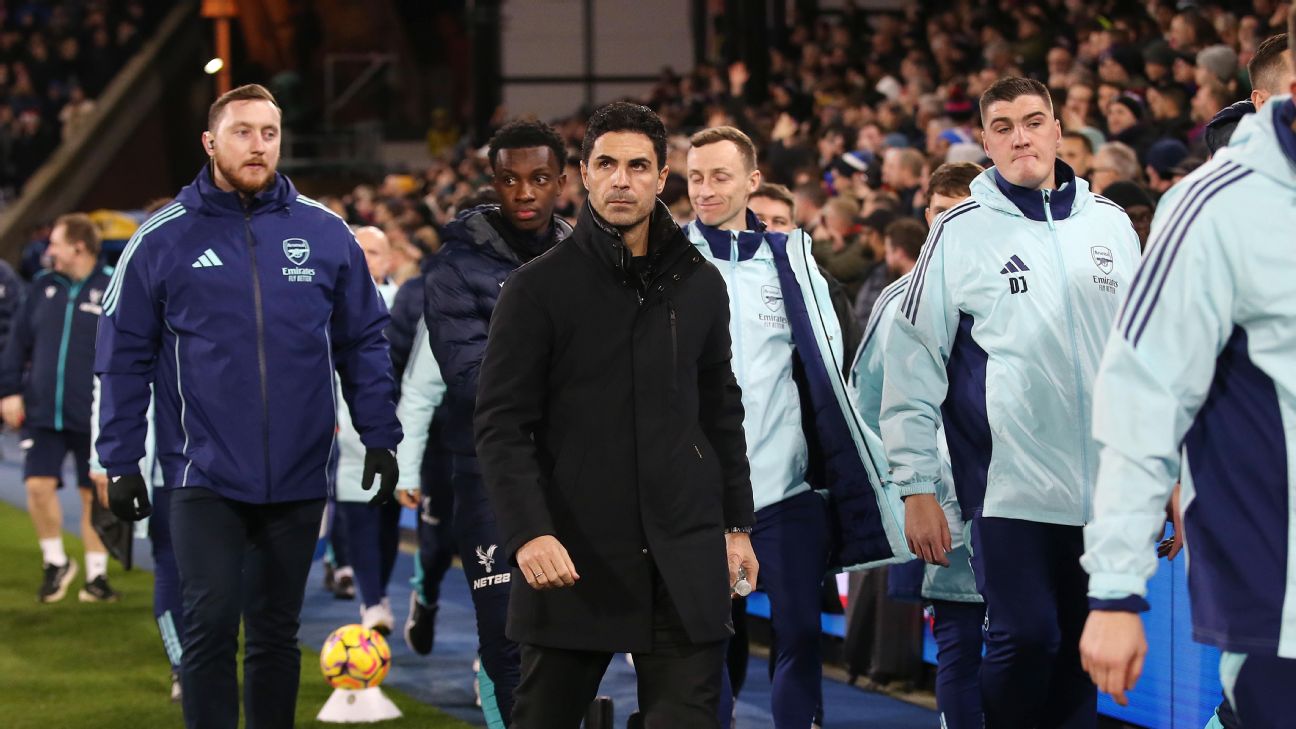For the most part, the best teams in the Premier League are the ones that create more chances than their opponents. The worst teams are the ones that do the opposite.
The top three teams — Manchester City, Arsenal and Liverpool — are the only three squads that attempt at least 65% of all the shots from chances created in their matches. (No one else in the league is above 55%.) Meanwhile, the bottom three, Luton Town, Burnley and Sheffield United, all attempt no more than 41% of the shots in their games. The only other team below that number, West Ham, just announced that their coach will be leaving at the end of the season.
This all applies even more when you control the quality of the attempts. Measured by expected-goal differential, the top three teams are all above plus-40, while no one else in the league is north of plus-20. As for the bottom three, they’re all at minus-28 or worse — no other team in the competition sits below minus-20.
But if we look at shot conversion, we stop learning about how the game works. Arsenal are third, Man City are fifth and Liverpool are 13th for the percentage of their shots that become goals. The bottom three consists of Everton, Sheffield United and Brighton.
So, over the course of the season, you win soccer games by creating more opportunities than your opponent, and you lose soccer games by letting your opponent do the same. But obviously, you actually score the goals by kicking or heading the ball into the net. If a team could figure out a way to score with 100% of the shots it takes, that team would only need to take three shots per game to be the best team in Premier League history.
But no team in the league is scoring with even 15% of its attempts this season. Of the 9,886 shots taken in the Premier League, 8,666 of them didn’t become goals. Some of those misses were more embarrassing than others, and a few of them had outsized impact on who might win the league, who might qualify for the Champions League, or who might get relegated.
And so, we present to you: a ranking of the worst misses of the 2023-24 Premier League season and a look at the misses that most affected the title race, relegation battle and Champions League qualification.
How we’re quantifying the ‘worst’
To assess the biggest misses of the season, we’ll mainly be relying on expected goals. The statistic is most useful in the aggregate — over a large sample of shots to present a clearer picture of a player or team’s underlying performance. When you hear someone talking about xG, they’re talking about a mathematical model that uses a collection of historical factors to estimate the goal-scoring probability of a given chance.
In the past, these models mainly used shot location and how the shot was attempted to predict goal-scoring probability. Over the long run, this paints a decent picture of who the best teams and attackers are. But, for instance, a shot from inside the six-yard box with the goalkeeper an inch away from the ball and five defenders on the goal line might be rated as more difficult than a 1v1 with a goalkeeper where a player shoots from outside the box. These are both rare types of shots, which is why the models are still useful in the aggregate, but basic xG is pretty much useless when applied to either example.
However, over time, expected-goal models have vastly improved — both because each shot attempted in a game gets added into the model and because of improvements in data availability and data capturing. The Stats Perform xG model, which we’ll be using, now has over 500,000 shots to learn from, and it includes new factors such as pressure on the ball when the shot is attempted, the number of defenders positioned between the shooter and the goal, and the positioning of the goalkeeper.
It’s still not perfect, and it will never be, but the model is more accurate than any human will be in quantifying the precise difficulty of a chance (A) because humans struggle to think in percentages that aren’t round numbers, and (B) because we all overestimate the likelihood that a given chance will be turned into a goal.
So with that, let’s now rank the worst misses of the Premier League season and see which ones had the biggest impact on the league standings.
The six worst misses of the Premier League season
So far this season, there have been 36 shots in the Premier League that the Stats Perform model rates with at least a 90% likelihood of being turned into a goal. Through 36 matchdays, 30 of those (83.3%) have become goals. That is, of course, below the expectation, but 36 shots isn’t many shots and 83% isn’t too far off from 90%.
These six misses all have one thing in common: they missed the target. My guess is that it’s nearly impossible for a goalkeeper to save one of these chances because the only way the model would rate anything this highly would be if the keeper were way out of position. This was certainly true for the biggest miss of the season…
1. Cole Palmer | Chelsea vs. Tottenham, May 5: 0.96 xG
Here’s how it looked:
It’s perhaps a little unfair to blame Palmer for this. The lost 0.96 of xG isn’t really his fault — he had almost no time to react to the ball being pinged directly at him by a Tottenham defender.
But a better way to think about this is that it’s incredibly unlikely for a player to get a foot on the ball in this situation — no defender or goalkeeper in sight, from four meters out — and for the ball to not end up in the goal. It’s not really Palmer’s fault. It’s mostly bad luck.
2. Beto | Everton at Chelsea, April 15: 0.95 xG
Once again, a highlight, this time of Beto missing a chance directly in front of the goal:
To me, this is more on the player than the previous chance. Beto is making a run and expecting the ball to be played into him, so his body should be primed to react athletically. He reacts … and then somehow clears the crossbar with a shot from two meters away and no goalkeeper in the way.
This interpretation of responsibility for these first two misses also jives with each player’s broader performance. Palmer has scored 12 non-penalty goals from 10.1 xG, while Beto has converted 6.0 xG into three goals.
3. Luca Koleosho | Burnley at Brentford, Oct. 21: 0.92 xG
Oh boy. This one is a real doozy:
This one is so egregious that we have to pull out the unfairly timed screenshot for this one:
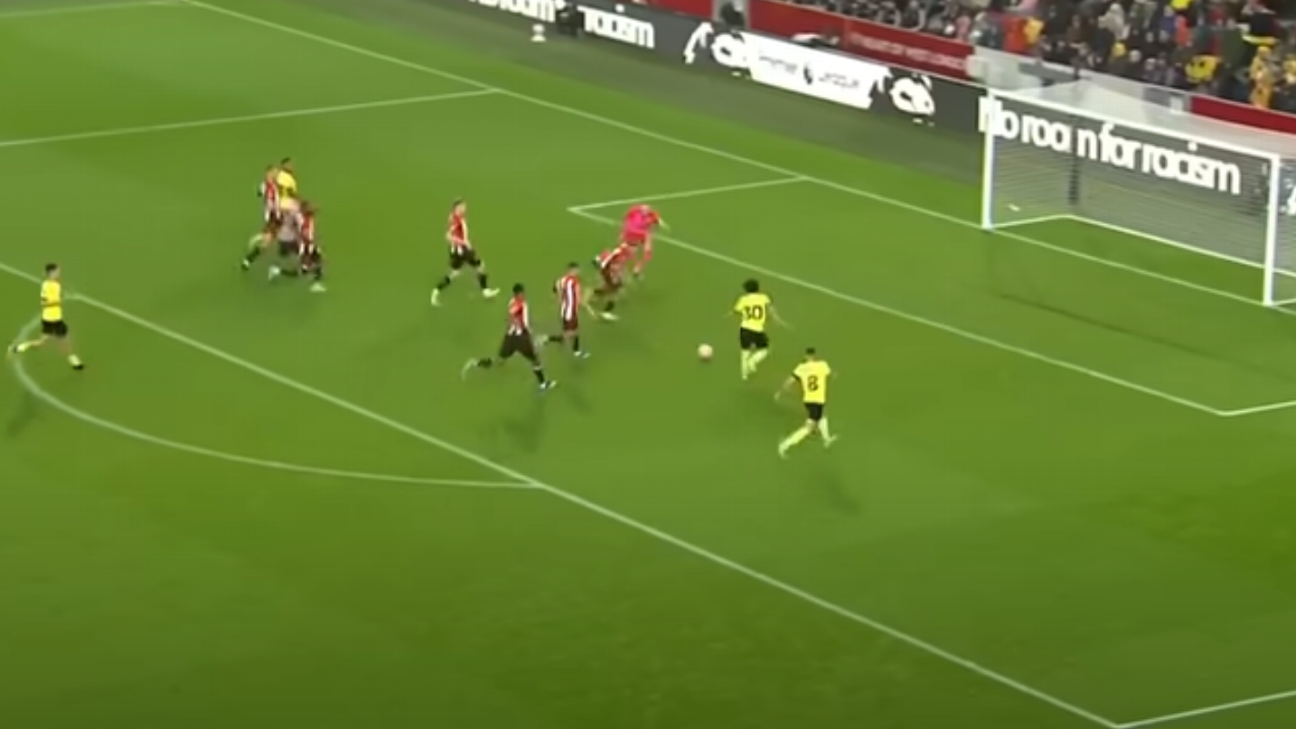
Somehow, that sequence ended up like this:
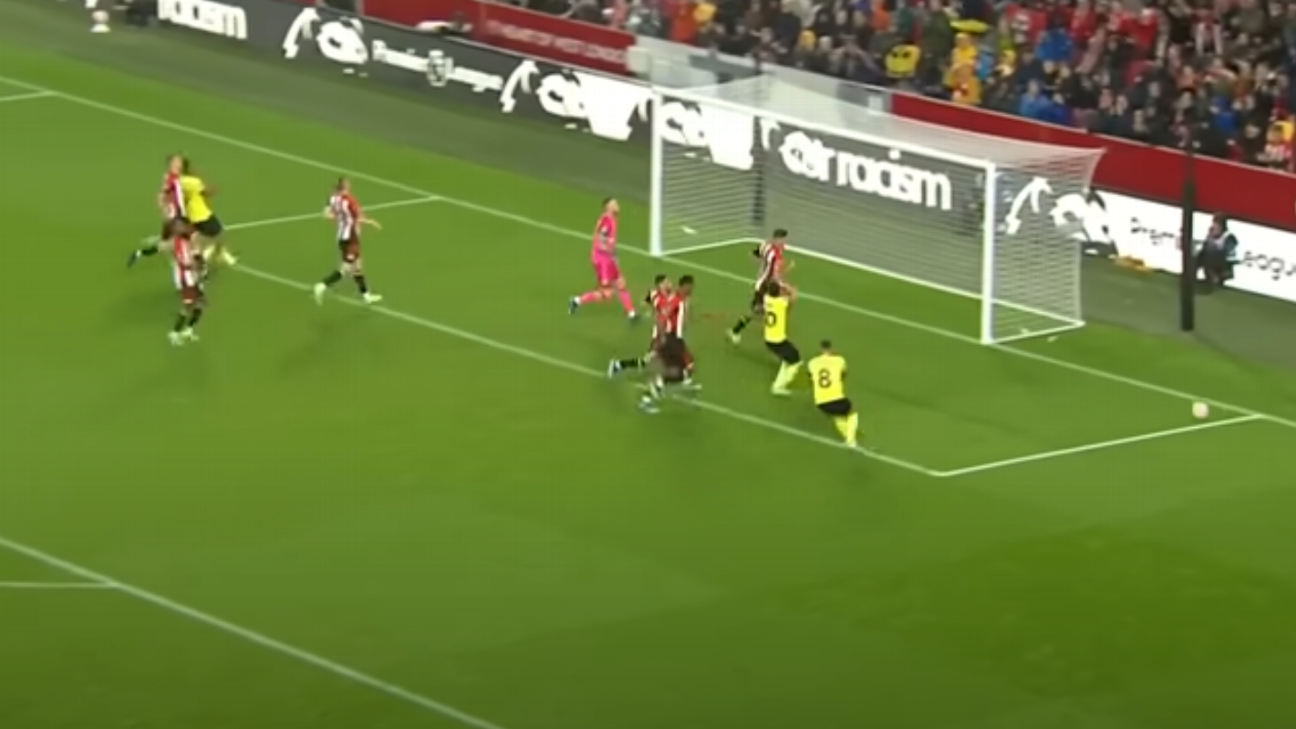
This feels worse than either of the other two.
Perhaps Stats Perform’s model should increase the xG when a miss is so bad that multiple players have already put their hands on their heads before the ball has gone out of bounds?
4. David Datro Fofana | Burnley vs. Brentford, March 16: 0.91 xG
[same exact voice from the previous section] Oh boy:
This looks like a Hieronymus Bosch painting:

Based on the past two shots, you might assume that Burnley were a horrible finishing team. You can just hear some commentator saying that their wastefulness in front of goal is what’s going to doom them to another season in the championship. Not quite, hypothetical TV personality!
Outside of these two shots, Vincent Kompany’s team actually scored slightly more goals than expected. The bigger issue: They’ve created 36.4 non-penalty xG through 36 games, the second-worst total in the league.
T-5. Ollie Watkins | Aston Villa vs. Fulham, Nov. 12: 0.90 xG
Even the best players in the league blow big chances every once in a while:
And yes, Ollie Watkins is one of the best players in the Premier League. Per Michael Imburgio’s DAVIES model, which essentially sums up everything a player does on the ball and then estimates how many goals he’s added or subtracted to his team’s performance, Watkins has added 10.39 goals to Villa’s standing in the table. The only players with more this season? Bukayo Saka, Erling Haaland, Mohamed Salah and Rodri.
T-5. Axel Disasi | Chelsea at Arsenal, April 23: 0.90 xG
Here’s what it looks like when a center-back tries to score:
A recent study into xG models found that “defenders are miscalibrated and underperform xG.” Since attackers take the majority of the shots in a match, the majority of shots in the xG model’s dataset comes from players who are theoretically better at converting the shots into goals. And so, broadly, that means that xG models aren’t actually spitting out conversion values for the average player but something closer to the average attacker.
Defender or not, though, a commentator would still be right to say “Disasi really should score there.”
The most meaningful misses in the relegation battle
The funny thing about the six misses we just went through is that none of them really mattered.
Chelsea won 2-0, so Palmer’s miss wasn’t costly, while Everton conceded six goals after Beto’s sky ball. Burnley lost 3-0 in the game where Koleosho whiffed, while Burnley won the game where Fofana fluffed his lines. Villa were already up 3-1 when Watkins skewed his header wide, and although it would’ve tied the score, Disasi’s miss came in a match that Chelsea ultimately lost 5-0.
So, what if we try to come up with a combination of high-quality chances that weren’t scored but also had a material impact on the scoreline of a match, whose result also had a material impact on a materially important section of the league table?
To do this, I only looked at shots that were worth at least 0.40 xG, and I only looked at matches that either ended tied or that would’ve ended differently had the miss gone in. And then I only looked at misses that might’ve significantly shaken up the races for the title, top four and relegation.
Turns out: there weren’t many huge misses in the relegation battle. I mean, there were huge misses, but none of them happened in a way that would’ve significantly shifted the way the standings currently sit. In a 1-1 tie against Brighton, Fofana misses a nearly identical chance (0.68 xG) to the one he missed against Brentford:
Had it gone in, though, Burnley would be tied for 18th with Luton and still significant underdogs to catch 17th-place Nottingham Forest, who are three points ahead.
The other big miss comes from Chelsea’s Nico Jackson, who put this one in the stands:
Had that 0.45-xG-chance gone in, Chelsea would’ve tied Forest 1-1 and they would be one point ahead of Luton Town heading into the final two matches of the season.
The costliest misses for the top teams on the Premier League table
Further up the table, though, there are nine misses in particular that stand out.
We’ll award some superlatives to help guide you past all the flying balls.
The biggest individual miss: Liverpool’s Gravenberch
It’s this one from Ryan Gravenberch against Brighton:
It was worth 0.62 xG and occurred with Liverpool up 2-1 in a match they ended up drawing.
There was another Gravenberch miss against Manchester United (0.41 xG) in their scoreless draw in December. Both go in and Liverpool are one point back of Arsenal. One goes in and they’re three back with two to play. Gravenberch has only appeared in a little over 1,000 minutes this season, but this just goes to show how important every minute can be when you’re trying to win the league.
The biggest collective miss: Liverpool’s Nunez and Salah
This one comes from Mohamed Salah and Darwin Nunez, who missed chances worth 0.51 and 0.48 xG on the same play in a frustrating 1-1 draw with Luton in the fall:
To calculate the goal-scoring probability of the play, you don’t just add up the xG. Otherwise, you’d get situations where the model is saying that a team created chances worth more than a single goal in the same sequence, which is impossible because a sequence ends if a single goal is scored.
Instead, we need to determine the likelihood that a goal is scored from at least one of those chances. To do that, we take the likelihood that a goal isn’t scored from either one (0.49 and 0.52), then multiply those numbers together (0.25), and then take the flip side to see that there was a 75% chance at least one of these shots went in.
The biggest miss in the Premier League title race
Well, there are three. The highest xG value comes from Luis Díaz’s missed breakaway against Man City:
Worth 0.44 xG, the chance probably would’ve been even better had Diaz attempted to go around goalkeeper Stefan Ortega.
The lowish seeming value of the attempt comes from a combination of (1) it being really hard to score a goal, and (2), Ortega being well-positioned and Kyle Walker putting pressure on the attempt. Even if a defender isn’t blocking the goal or physically touching the attacker, their nearby presence typically lowers the expected conversion rate because attackers will rush their shots, like Diaz did here. Had the Colombian scored, it would’ve meant two more points for Liverpool and one fewer for City.
Same goes for Trent Alexander-Arnold’s shot into the crossbar against Arsenal on what ended up being a 5-2 fast break during their match in December:
I mean, just look at this:

TAA’s chance ended up being worth just 0.42 xG, which probably undersells the situation for arguably the best striker of the ball on the planet. Had Diaz and Alexander-Arnold converted these chances, Liverpool would have four extra points, while Arsenal and Man City would each be two back. Or, Liverpool would be in first place with two games left to play.
If it seems like I’m only focusing on Liverpool, that’s because Liverpool have created 81.5 xG through 36 games, while Manchester City (73) and Arsenal are way behind (71.7). Despite that, Liverpool have scored 76 goals this season, while Man City are at 87 and Arsenal lead the league with 88.
The main reason Liverpool aren’t still in the title race is that their opponents finished their chances well above expectation, while Jurgen Klopp’s team fell well below theirs. There were also 0.4-xG-or-more misses in the 2-2 tie against Manchester United, the 2-1 loss to Tottenham at the beginning of the season, and then a pair in the 1-0 loss to Crystal Palace last month.
(If you’re wondering why there’s not more Darwin in this piece: He’s missed nine chances worth at least 0.4 xG this season — tied with Erling Haaland and Dominic Solanke for most in the Premier League — but only one happened in a game that Liverpool drew or lost by one goal.)
As for non-Liverpool title race misses, the biggest one falls to Nathan Aké, whose header didn’t make the highlight package but looks quite bad when you freeze the frame like this:
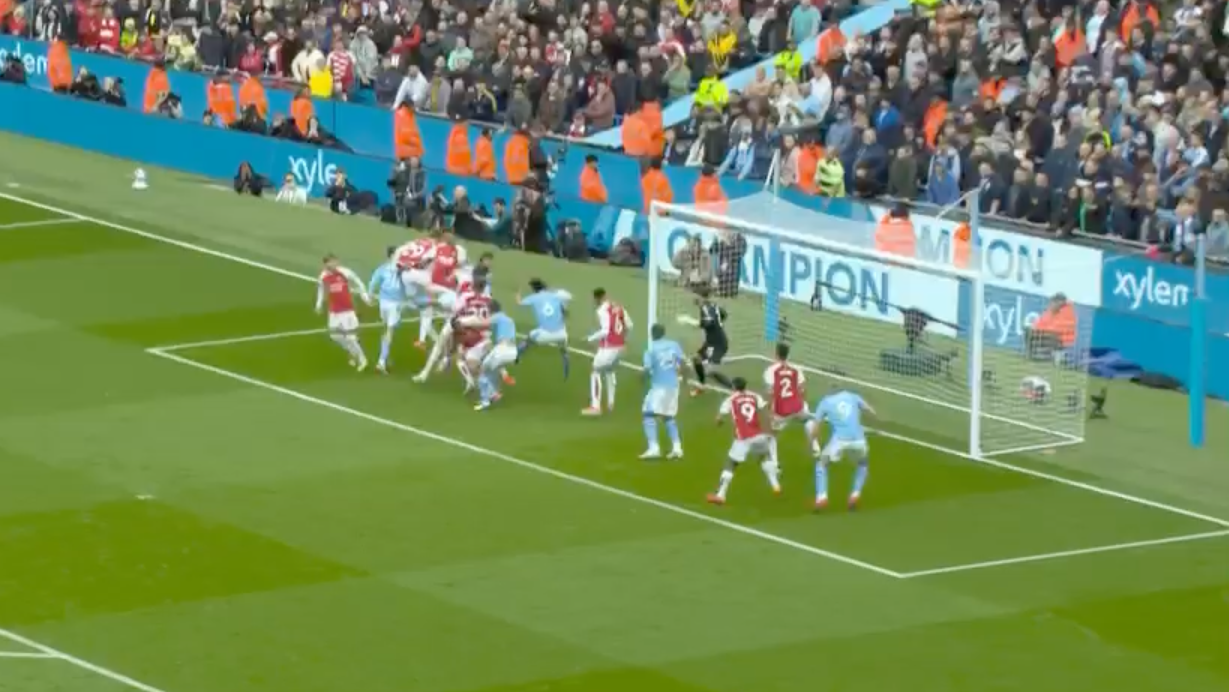
There he is, No. 6 at the near post a couple feet from the goal. That attempt was worth 0.41 xG, and it would’ve put Man City up 1-0 in a match they ended up losing 1-0 thanks, funnily enough, to a deflected shot off of Nathan Ake. Had his header gone in, the title race might already be over.
And had this gone in, the Champions League race might still be on.
The biggest miss in the battle for fourth
This one came from Dejan Kulusevski, who hit the post in the third minute against Aston Villa at the end of November:
This was worth 0.56 xG and occurred in the third minute of a match Tottenham lost, 2-1.
You could at least make the argument that an early goal would’ve made Spurs heavy favorites to win the game. And had they done that, they’d only be one point back of Aston Villa, who play Liverpool this weekend.
Of course, you can forget about that if you remember Arsenal’s highest-profile miss of the season, from Gabriel Jesus in the season’s first North London Derby:
The chance was worth 0.43 xG, but it wasn’t…
Arsenal’s biggest miss of the season
No, the Gunners’ biggest misfire came from Bukayo Saka, in the 31st minute of a 2-2 home draw with Fulham back in August:
This was worth 0.53 xG, and it’s the third-biggest miss by an Arsenal player this season, but it’s the only one that came in a game that they either drew or lost by a single goal.
So, with two games left, Arsenal are leading the league in both goals scored and goals against. Despite that, they’re still unlikely to win the league. One of the simplest ways to explain how that could be possible: they missed one truly meaningful better-than-50% chance this season, while Manchester City haven’t missed a single one.

